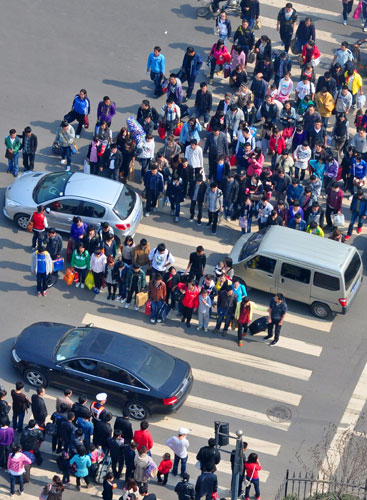Officials to clamp down on jaywalkers
Updated: 2012-10-29 07:38
By Tan Zongyang (China Daily)
|
||||||||
If traffic officials in Shijiazhuang have their way, pedestrians will no longer be able to defy red lights and cross the streets any time they please without fear of punishment.
Authorities in the city, the capital of Hebei province, have begun imposing fines as high as 50 yuan ($8) on jaywalkers as part of a trial campaign meant to stop people from crossing roads at the wrong times and places.
The new rules treat pedestrians attempting to move across large and small intersections differently. When groups of pedestrians cross large intersections in defiance of red lights, the first three of their members will be fined; at smaller intersections, all jaywalkers will be punished, Wu Ruiqi, director of the Shijiazhuang traffic management bureau, was quoted as saying by Legal Daily.
|
 A group of pedestrians jaywalk across a road in Taiyuan, capital of Shanxi province. Deng Yinming / for China Daily |
The trial comes in response to a heated debate that arose online in China about the "Chinese style of crossing the road", a term referring to the tendency of large crowds of people to cross roads in disobedience of red lights.
The controversy became more heated after someone posted a comment on Sina Weibo, a micro-blogging site, saying "the Chinese way of crossing roads is to cross them without taking traffic lights into consideration, so long as you are part of a crowd".
In a China Central Television news program this month, a video showed more than 600 people walking through red lights over one hour at a crossroads in Shijiazhuang.
Some said the Chinese believe authorities are reluctant to punish large numbers of people at once and thus don't mind violating the rules in groups.
"I believe that imposing fines is not the ultimate purpose of this campaign," said Zhang Yanchen, a 25-year-old resident. "This will at least have the effect of changing people's notion that offenders can avoid being punished."
Zhang Yajun, an employee at a telecommunication company in Shijiazhuang, said she still sees people who disobey red lights in places downtown - even at times when police are obviously stationed at crossroads.
"It will be difficult to identify who the first three rule-breakers are when a group of people walk through a red light. In these sorts of case, there could be disputes when the police try to fine offenders and that could lead to traffic jams."
Zhang Yajun said the new policy will help to moderate the behavior of pedestrians, cyclists and motorcyclists, a goal that she says is more important than helping them save a few seconds.
The argument also raised questions about how long pedestrians should be kept waiting at red lights.
"The waiting time in front of a traffic light can affect pedestrians' behavior," Ni Ying, a member of a research team at Tongji University's School of Transportation Engineering, was quoted by Xinhua News Agency as saying. "They are more likely to ignore the light when the time they have to wait is longer than they can stand."
From 2008 to 2010, Ni's team conducted research on pedestrians' waiting times at various road crossings and found a correlation between jaywalking and the length of time they had to halt their progress before the light changed.
Their study found the Chinese to be "very patient", saying they would wait up to 90 seconds on average for the light to change. The British, in comparison, would wait 45 seconds and the Germans 60 seconds.
But Chinese people's apparent greater patience may not be enough. The study noted many red lights last for more than 90 seconds.
Ni said the design of traffic lights in China is better suited to regulating automobile traffic, thus tempting pedestrian to break the rules.
Zhang Changqing, director of Beijing Jiao Tong University's Institute of Transportation Law, said the new policy violates the spirit of the law, saying everyone should be treated equally.
Zhang also called for a greater use of public transport. That, he said, will help relieve road congestion and prevent pedestrians from spending great lengths of time at intersections waiting for the light to change.
Zheng Jinran contributed to this story.
tanzongyang@chinadaily.com.cn

 Relief reaches isolated village
Relief reaches isolated village
 Rainfall poses new threats to quake-hit region
Rainfall poses new threats to quake-hit region
 Funerals begin for Boston bombing victims
Funerals begin for Boston bombing victims
 Quake takeaway from China's Air Force
Quake takeaway from China's Air Force
 Obama celebrates young inventors at science fair
Obama celebrates young inventors at science fair
 Earth Day marked around the world
Earth Day marked around the world
 Volunteer team helping students find sense of normalcy
Volunteer team helping students find sense of normalcy
 Ethnic groups quick to join rescue efforts
Ethnic groups quick to join rescue efforts
Most Viewed
Editor's Picks

|

|

|

|

|

|
Today's Top News
Health new priority for quake zone
Xi meets US top military officer
Japan's boats driven out of Diaoyu
China mulls online shopping legislation
Bird flu death toll rises to 22
Putin appoints new ambassador to China
Japanese ships blocked from Diaoyu Islands
Inspired by Guan, more Chinese pick up golf
US Weekly

|

|






